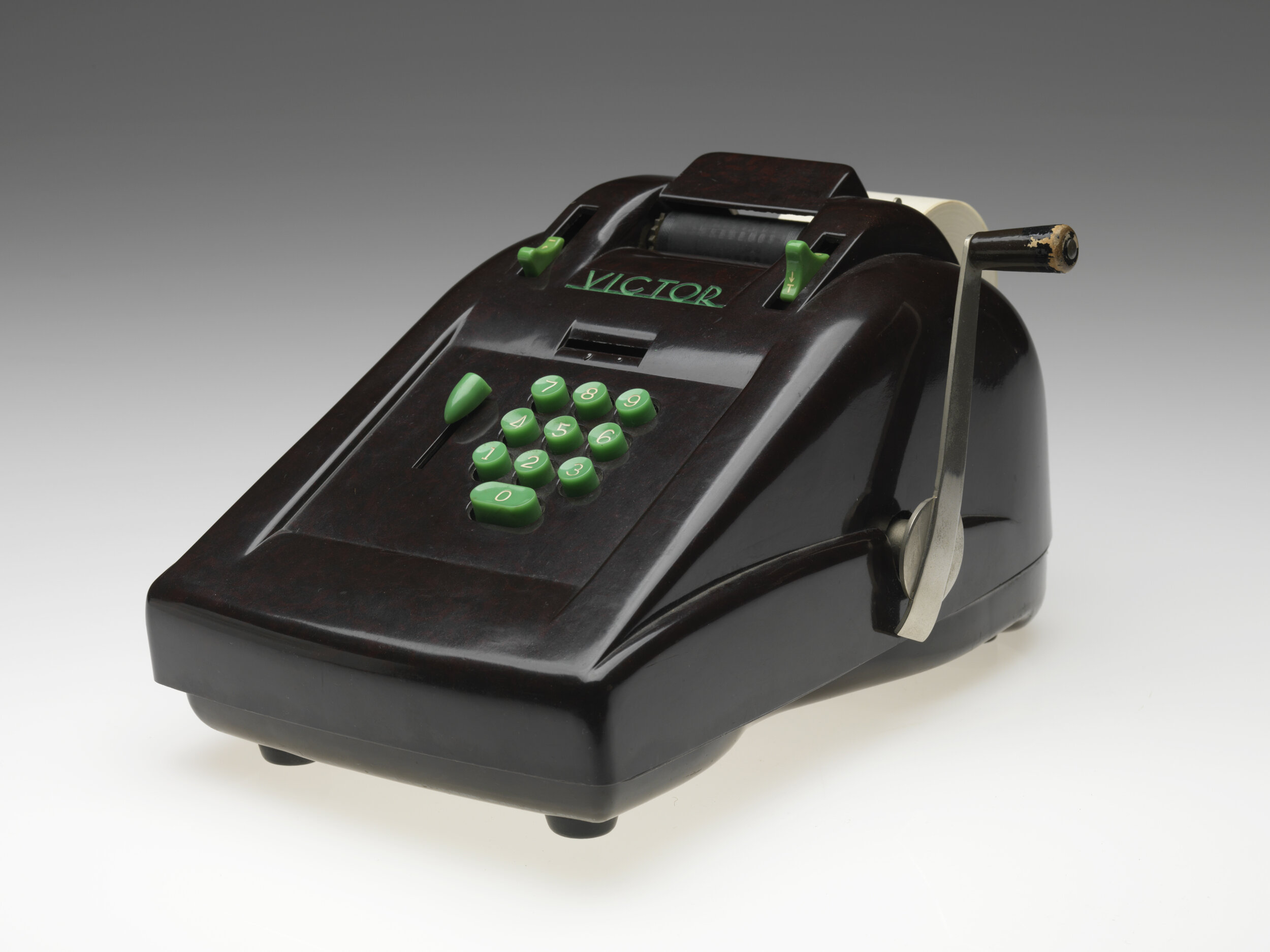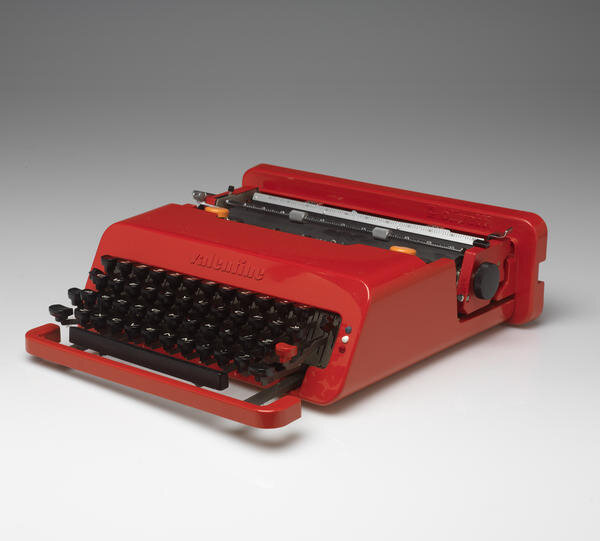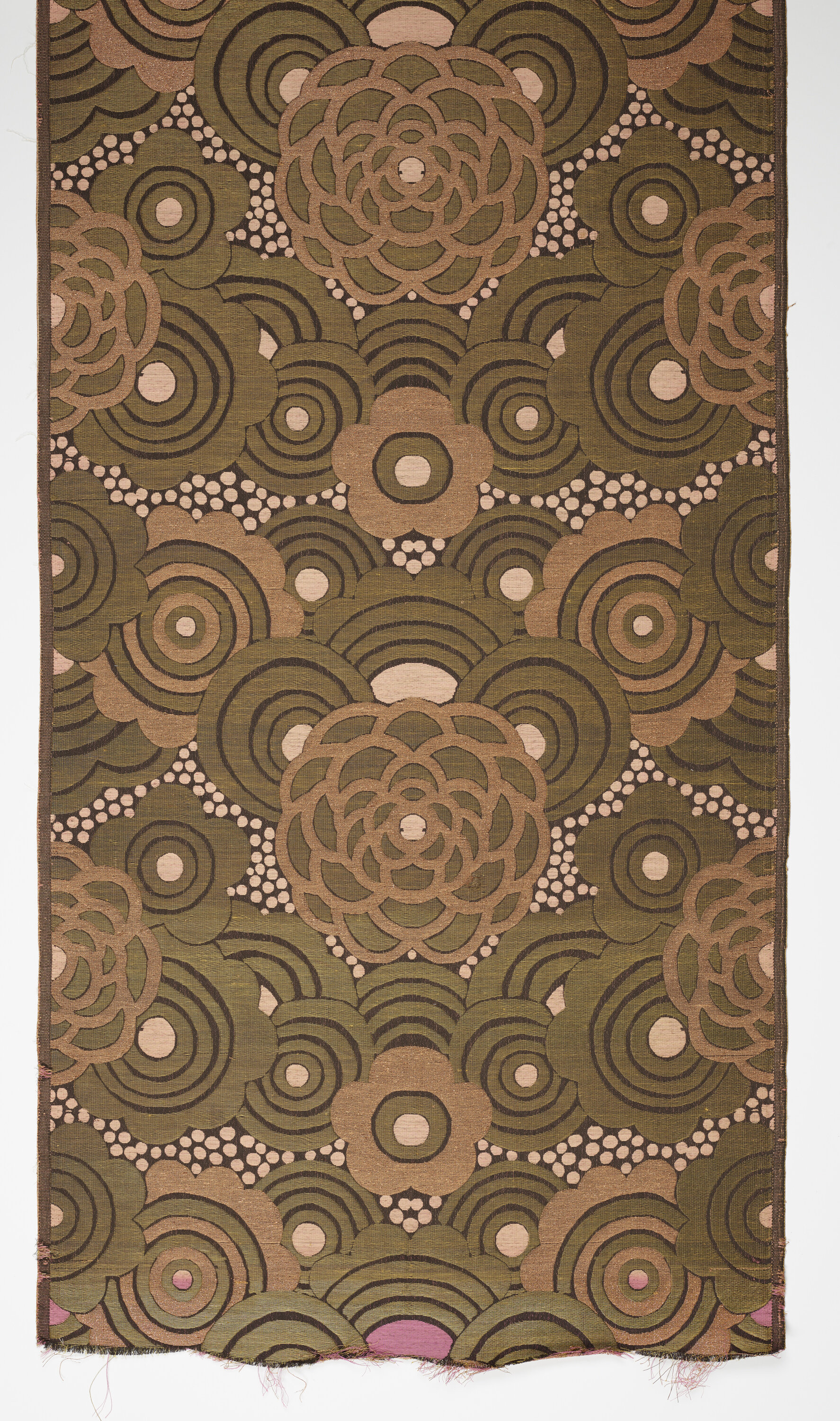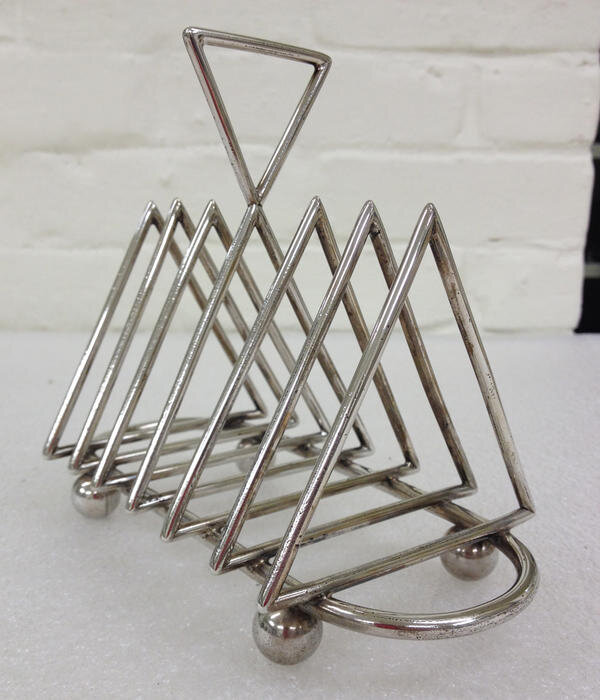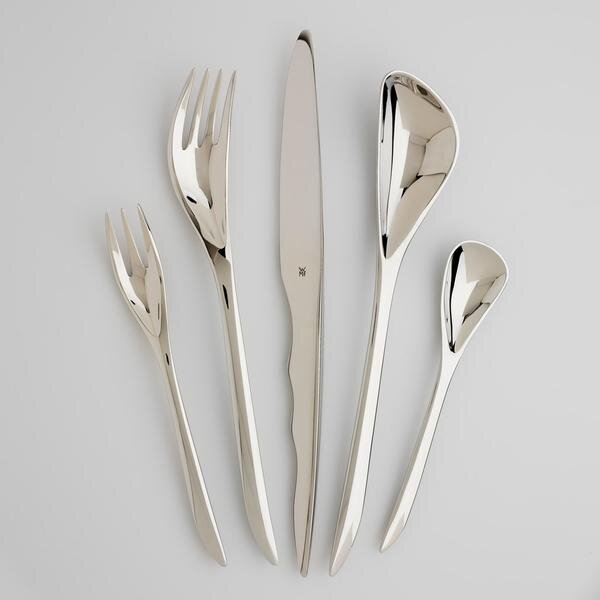VOTIVE OFFERINGS: GLENN GISSLER AT RISD
This essay is about a plentiful cache of the most rarefied—and sometimes recondite—decorative art objects produced in the last two centuries contained in architect-designer Glenn Gissler’s applied arts trove. Since 1984, Glenn has been gifting these objets to the Rhode Island School of Design Museum of Art in an effort to augment the RISD Museum’s modern design collection. Glenn himself holds degrees in both Fine Art and Architecture from RISD, and the 200 or so smaller objects he has donated to the RISD Museum reflect an architect’s discipline; a connoisseur’s delectation.
2005; Ettore Sottsass, Jr., Italian, 1917-2007; and Perry A. King, British, 1938- . Olivetti Manufacturing Company, Italian manufacturer, 1908-present. Valentine Portable Typewriter and Case, 1969. Plastic, rubber and metal. 10.2 x 32.7 x 32.7 cm (4 x 12 7/8 x 12 7/8 inches).
You can only fill a room with so many finds—even all exquisite ones—without sacrificing space and grace. Thus began, in 1984, interior designer Glenn Gissler’s secondary career as independent hunter-gatherer for the Museum at his alma mater. From seeking and surplus, edits and purges, Glenn has helped to meet the RISD Museum’s evolving need for a collection on modern design.
2013; Dr. Christopher Dresser, Vase, c. 1875, Minton Pottery Factory, English manufacturer, 1793-present. Porcelain with enamels and gilding. 20.3 x 12.7 x 12.7 cm (8 x 5 x 5 inches).
Glenn has set for himself a lifetime goal of a thousand gifts for the RISD Museum. Knowing his eye for both sober classics and space oddities, I predict the collection at the RISD Museum, influenced by his contributions, will be unique in revealing the tremendous variegation among the applied arts from the late 19th century up to our own. “Modern design” is invariably invoked as an iconoclastic matrix of new rules, when in fact, like all movements, it imitates the past even while critiquing it. As critic Peter Schjeldahl brilliantly remarked in The New Yorker recently. “I like to say that contemporary art consists of all art works, five thousand years or five minutes old, that physically exist in the present. We look at them with contemporary eyes, the only kind of eyes that there ever are.”
2013; Gio Ponti, Italian, 1891-1979. Flatware Set, 1951, Stainless Steel.
A personal aside is in order. I first met Glenn in 1994, answering with alacrity his ad for an assistant in the old classified section of The New York Times. It was no slam-dunk. Glenn interviewed me two or three times, hesitant because I had no drafting skills, only a spread on my former flat in The World of Interiors. All my academic training was literary and (art) historical rather than practical, but I longed to lose myself in things instead of thoughts. I had not yet realized that writing requires hardly any thoughts at all; but rather, a good ear and an indefinable grip on the look of words on a page, not unlike brushstrokes on a canvas.
Glenn did the kind, impractical thing and hired me. As always, I would be fired after an interesting run, yet here we are, a quarter-century later, still speaking, and always learning from each other.
1997; French, textile length of cotton from the 1920s. 182.9 cm (72 inches).
Glenn is master of a profession notable for its pleasures, but also for its innumerable near-unmanageable subdivisions—including personalities and payments. For Manhattan’s stylish residents, interior design is often a necessary caparison, but it is a coat of many colors. Its cut hinges on the client every bit as much as the creator. Interior design is a collaborative art.
The first strange lesson I learned in Glenn’s studio was how to build an interior from the ground up, literally from floor-covering. My assignment was to find viable samples of carpet for an immense master bedroom, a task which introduced me to the legendary showrooms of high end textile merchants at the Design and Decoration Building on Third Avenue and 59th Street. It set me thinking more concretely about containers as opposed to the objects which had been the very reason for my decorating adventures. I had often lived with bare floors and windows. Glenn saw rooms in reverse from the way I did, with textiles preceding even wall colors. I adapted to his thinking, becoming fascinated with the unending weaves and colors of cloth and carpets.
Beneath his virtuous, level-headed work on structure, Glenn was as much a fetishist as I. He had the sense, however, to make of precious Christopher Dresser silver and ceramics, among other coveted artifacts, an aesthetic apogee rather than a platform. With his ineffable eye for beauty spiked with peculiarity, he has, since 1984, sought out objects from about 1870 to the present that exemplify both great movements in design and the individuality of those movement’s makers. While our decorating strategies differ, Glenn and I agree there is something uniquely moving about an applied art object, perhaps because its meaning and use can be understood almost instantaneously by every kind of consumer and observer.
1984; C.F. Jacobs, American, 20th century. Valle’s Steak House, Warwick, Rhode Island, c. 1960. Gouache. 41.3 x 74.3 cm (16 3/16 x 29 5/16 inches).
Like many a collection, the one still being amassed by Glenn for the RISD Museum began through serendipity and has accelerated ever since. From May to June 1982, the RISD Museum, in collaboration with Brown University, held a seminal exhibition called “Buildings on Paper,” of Rhode Island architectural drawings from 1825 to 1945. It was accompanied by the sort of august volume for which the museum was noted, with even its twentieth century entries hearkening back to Beaux-Arts grandeur rather than pared down modernism. On impulse, Glenn threw a paper grenade into this bastion of tradition. He sent the RISD Museum his first donation, a slightly camp, Venturi-esque 1960s rendering of a steakhouse which he had found in Providence and thought should stay there. It was a call to the RISD Museum to gaze forward as well as back, to document where, like it or not, architecture is going as well as where it’s been.
Glenn’s second gift to the RISD Museum, in 1997, was a textile, a curious fragment with metal threads woven into a small scale art deco floral design. He had cherished it for a few years, but it was too small to use for upholstery, so he sent it to the RISD Museum.
But it was his third contribution, in 2005—boxed up, addressed, and sent with a “naive simple note”—that provoked some initial resistance from the RISD Museum curators to collecting and displaying modern design, especially items industrially produced. Glenn’s gift was a curvaceous plastic adding machine from the 1950s which he erroneously believed to be designed by Raymond Loewy. (In fact, it was designed by Oscar Sundstrand in 1939 for the Victor Adding Machine Company.) RISD’s initial response: “The Museum doesn’t collect design.” Nevertheless, the adding machine would be the first plastic artifact to enter the RISD Museum’s collections.
2014; Dr. Christopher Dresser, Scottish, 1834-1904, Loetz-Witwe manufacturer, Bohemia, 1836-1947. Max Emanuel & Co., retailer, c. 1845-1914, Diana Cisele Vase (Series II, No. 251), c. 1899. H 10.5 cm (4 1/8 inches).
The RISD Museum’s founding is an impressive tale of ingenuity—and genealogy. The 1877 Philadelphia Centennial Exhibition, participated in by the 34 members of the Providence East Side College Hill Ladies, found themselves with $1675 left over from their budget. With this sum, they thought at first to build a public fountain. Under the leadership of Helena Adelia Rowe Metcalf, they resolved instead to found a school and museum of art and design. Helena Metcalf was an unusually powerful woman for her time. She raised money, encouraged students, supervised teachers and arranged furniture. When necessary, she swept the classroom floors. A mother of five, she remained Director of the School until her death in 1895.
Helena’s husband, Jesse Metcalf, covered the School’s losses for years. After she died in 1895, he donated a building, land and three exhibition galleries in her memory. Their son, Steven Metcalf, became the school treasurer in 1884. Another son, Jesse, became a U.S. senator and RISD trustee. In 1913, their daughter Eliza Greene Metcalf Radeke became President of the School and served for eighteen years. Her husband, Dr. Gustav Radeke, contributed to the RISD Museum casts, models and industrial materials he had collected in Europe. From 1931 to 1947, Eliza’s daughter, Helen Metcalf Danforth, served as President of RISD, and then chair of the board of trustees until 1965. 150 years later, the Metcalf family is still involved with the design school and Museum, along with other early families: the Aldriches, Browns, and Spragues.
2013; Ettore Sottsass, Jr., Italian, 1917-2007. Memphis Milano, Manufacturer, Italian, 1981-1987. Tahiti Lamp, 1981, Laminate and metal with enamel. 63.5 x 38.1 x 10.2 cm (25 x 15 x 4 inches).
Providence, like Charleston, was a very important 18th century port, rich in the jewelry and silver industries rather than slaves. By 1875, there were 130 jewelry companies in Providence, employing 2700 workers. The city soon became the American fulcrum of silverware production.
The RISD Museum‘s focus on fine art and lavish craft-based decorative arts was for the edification of the scions of old Providence’s most prominent families. The families with money from shipping and manufacture were sophisticated, but had little art in Providence for the next generation to look at. Their inaugural focus on collecting was 18th and 19th century classical drawing and sculpture rather than progressive art and design movements, although the School itself was very much intended to be a school of design—to teach those who would be working and designing in the local trades of jewelry, silver and textile.
Along with this goal, by the 1880s RISD was a school for affluent young people seeking to cultivate connoisseurship. Unlike its design school brethren across the pond—most notably the South Kensington Schools—RISD was not solely dedicated to improving American manufacturing or decorative arts. Local collectors began to donate fine art. Sterling silver, produced by Providence-based Gorham, did find is way into the collections from the beginning. The RISD Museum recently held a major exhibition on its native Gorham, with an accompanying book published by Rizzoli.
The RISD Museum has been graced with some venerable patrons, notably the late David Rockefeller, who, as a Harvard undergrad, would go to Providence to visit his aunt, Abby Aldrich, who showed him around the museum, his introduction to fine art. His will provided for the position of Rockefeller Curator of Decorative Arts and Design, currently held by Elizabeth Williams. Through several generations, the Rockefellers have been committed to the Museum. Indeed, it possesses the Rockefeller galleries for Asian art; and one room for Asian works on paper, a gallery designed by Philip Johnson.
Into this fine art repository poured Glenn Gissler’s cascade of modernity. Assiduously he combed then-unorthodox sources such as eBay or little-known auctioneers for undervalued modern icons: “I gave silverplate and ceramics by Dr. Christopher Dresser for Hukin & Heath. My idea was to inspire later generations going into the future. I’ve had a rich relationship with these objects and can pass them on.. The way the silver was displayed, originally, was in old cases, and therefore often unnoticed. A new grad student came in and asked the curator about silver by Dresser. Why was this 19th century work at an avant-garde art school? So the curator took her into the back to see more. The lightbulb went off. It became the student ‘s gateway drug to 19th century design and she sent me a thank you note!” Glenn’s unusual depth as a designer has led him to include works by such far-flung international designers from the entire 20th century as Raymond Loewy, Russel Wright, Gilbert Rohde, Josef Hoffmann, Peter Behrens, Wilhelm Wagenfeld, Eva Zeisel (nee Stricker), Gio Ponti, Ettore Sottsass, Matteo Thun, Joe Columbo, Aldo Rossi, Massimo Vignelli, Dieter Rams, Ted Muehling, and Zaha Hadid.
2004; Attributed to Dr. Christopher Dresser, Scottish, 1834-1904, Toast Rack, c. 1880, silver plate. 14.6 x 17.8 x 9.5 cm (5 13/16 x 7 x 3 13/16 inches).
Glenn explains, “Historically, museums don’t depend upon freelance collectors, although there have always been such. They have a committee. And they didn’t look on eBay and probably still don’t. But I, as a donor, can do that and give it to the museum. I also watch modern auctions, getting in on the ground floor of the up-and-coming via second or third tier auction houses, in New Jersey, Chicago and various places, where I could make ‘stealth purchases’. And even on eBay, I found Robsjohn-Gibbings at low prices. Mass-produced but lovely. You’d get these very beautiful tables for Widdicomb that had slightly tapered legs and then they would be almost as simple as Judd, but with a Classical filter.”
2008; Dr. Christopher Dresser, Vase, c. 1862. Minton Pottery Factory, English manufacturer, 1793-present. Porcelain with gilding, 16.5 x 15.7 x 9.4 cm (6 1/2 x 6 3/16 x 3 11/16 inches).
Glenn continues, “Shopping on eBay is like an amazing library; an intellectual genealogy. eBay would shrewdly see my searches then invite me to look at related things. In my personal process of finding things, I take delight in serving as a sort of cultural editor. Then the museum takes on the chore of looking after the objects. It’s a way of participating in culture without writing a million dollar check to the Met. You could get things that were undervalued. I was opportunistic. Sometimes I would spend more money, but it was about bringing passion to the hunt; a sort of clairvoyance.”
“I’d go to MoMA design and see what they collected. This was twenty years ago or more. I saw Peter Behrens. And Russel Wright; Josef Albers; Anni Albers; Josef Hoffmann. Then there was newer industrial design, Braun appliances designed by Dieter Rams which I thought they should be in the RISD museum while still available cheaply. So some stuff I’ve given to the RISD Museum was cheap but now is much higher in value.”
2010; Zaha Hadid, British, b. Iraq, 1950-2016, Cutlery Set, WMF, German, no date.
Glenn’s donations to the RISD Museum thread their way loosely, slightly idiosyncratically through the canonical narrative of progress in design since the 19th century set forth by the historian Nikolaus Pevsner. Glenn begins with the great botanist Dr. Christopher Dresser, many of whose designs, particularly those in silver, outstrip Bauhaus vessels in their scathing simplicity, all the more startling considering they were designed and made in the early 1870s, nearly fifty years before the Bauhaus Manifesto of 1919. In ceramic, Dresser looked to Japan and to pre-Colombian art. Indeed, it was Dresser at the Philadelphia Centennial of 1877 who lectured on the vitality of American design and emphasized the importance of design museums as places to elevate industrial manufacture—a lesson not lost on Providence’s East Side College Hill Ladies!
The stern creations of Donald Judd would follow. “Many things, including my Judd desk, are things I lived with for a long time. After I’ve gotten all I need from the item, I’m ready for something else.”
2012; Donald Judd, American, 1928-1994, Desk Set #33/97, 1992; Finland Color plywood (green), 101.6 x 121.9 x 83.8 cm (40 x 48 x 33 inches; desk).
Glenn’s program of giving also includes spectacular works on paper, some bought specifically for the RISD Museum by Josef Albers, Sol LeWitt, Alfonso Osorio, Kiki Smith, Pat Steir, Ivan Albright, and the late Leon Golub whose estate is now represented by David Zwirner. “I was friends with Nancy and Leon Golub, who died in his eighties. His prints were on eBay for $100. He left many undated though they were signed. Students love the passion and commitment of Nancy and Leon.”
2011; Donald Judd, American 1928-1994. Chairs, 1993; Finland Color Plywood; 76.2 x 38.1 x 38.1 cm (30 x 15 x 15 inches).
Glenn reflects in summation, “The RISD Museum might have been vaguely modeled on the Wadsworth Atheneum Museum of Art in Hartford, Connecticut—an old fashioned portmanteau museum; originally an amenity to the school, yet not a study collection. The prolific ceramist Russel Wright was living and working during the same era as Frank Lloyd Wright. Yet why did I go to RISD and not hear about Russel Wright until ten years later? My mission is to see all this information interwoven into a unified history of architecture, applied, and decorative arts. Now it is truly a study division, engaged with departments and professors. The school and museum must be intertwined. I got involved twenty years after graduating. I wanted to be the one pounding the table and saying what about the students drawing inspiration from the museum? When I was at RISD, the Industrial Design department had thirty students, lodged in a semi-basement. Now it is the single largest department at the school, with 600 students—more than are majoring in architecture. Industrial Design is the school’s most cross-disciplinary course. You can take graphic design, weaving, fashion--all elements of fine art is done today--so it’s the most sought-after degree.”
2007; Russel Wright, American, 1904-1976. Steubenville Pottery, American, 1879-1959, Covered sugar bowl, 1937; Earthenware with “chartreuse glaze, 9.2 x 15.9 cm (3 5/8 x 6 5/16 inches).
